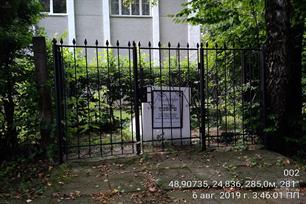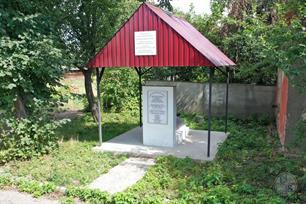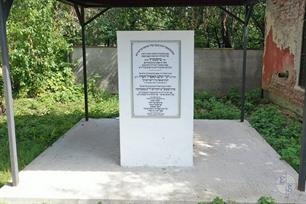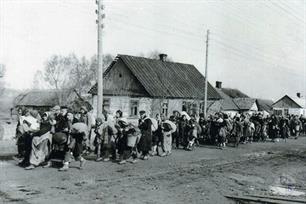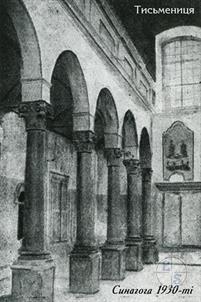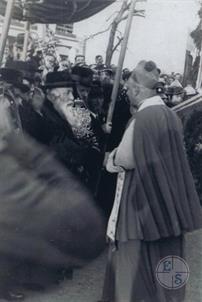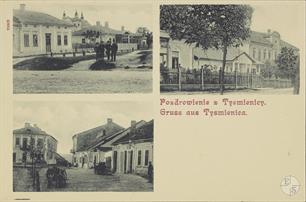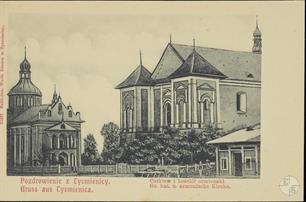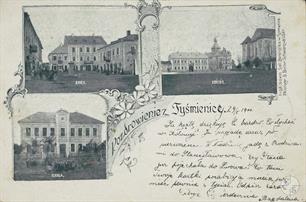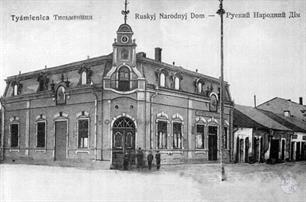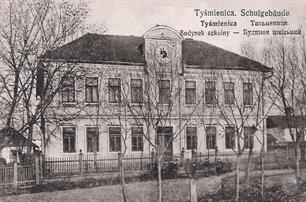Tysmenytsya
Sources:
- Jewish encyclopedia of Brockhaus & Efron
- Virtual Shtetl. Tysmenytsya
- Blond S., Tismenits; a matseyve oyf di khurves fun a farnikheter yidisher kehile, Tel Aviv 1974.
- Chirowski D., Dzieje miasta Tyśmienica, Lwуw 1938.
- Холокост на территории СССР: Энциклопедия / Гл. ред. И. А. Альтман. - М.: Российская политическая энциклопедия (РОССПЭН): Научно-просветительный Центр «Холокост», 2009
Photo:
- Jewish Cemeteries Initiative. Tysmenytsya New Jewish Cemetery, Oldest Jewish Cemetery
- Biblioteka Narodowa Polona. Tyśmienica
- Portal Polska-org.pl. Tyśmienica (Тисмениця)
- Місто Тисмениця. Євреї Тисмениці
- Jewish encyclopedia of Brockhaus & Efron
- Virtual Shtetl. Tysmenytsya
- Blond S., Tismenits; a matseyve oyf di khurves fun a farnikheter yidisher kehile, Tel Aviv 1974.
- Chirowski D., Dzieje miasta Tyśmienica, Lwуw 1938.
- Холокост на территории СССР: Энциклопедия / Гл. ред. И. А. Альтман. - М.: Российская политическая энциклопедия (РОССПЭН): Научно-просветительный Центр «Холокост», 2009
Photo:
- Jewish Cemeteries Initiative. Tysmenytsya New Jewish Cemetery, Oldest Jewish Cemetery
- Biblioteka Narodowa Polona. Tyśmienica
- Portal Polska-org.pl. Tyśmienica (Тисмениця)
- Місто Тисмениця. Євреї Тисмениці
Ivano-Frankivsk district, Ivano-Frankivsk region
Tysmenytsya (Ukrainian: Тисмениця) is a city in Ivano-Frankivsk region.
In 1765, in Tysmenytsya lived 898 Jews, and 56 - in surrounding villages,
in 1880 - 2548,
in 1900 - 2049 (38.5%),
in 1921 - 1090,
in 1939 - 1180 Jews (15.3%).
The Potocki family, who used to own the town, initially supported the development of the Armenian community of Tysmenytsya. Jews, whose presence in the town had been recorded since the 15th century, had to make considerable efforts to set up their own independent institutions. The community was probably established in the late 17th century.
In 1759, Jews built a brick synagogue in the town. The construction was approved by Archbishop of Lviv Wacław Sierakowski on the condition that “it is built away from churches and Catholic buildings, it is 42 ells long, 38 ells wide, and it is neither higher from nor equal in height to churches, its structure is simple, with no unnecessary decorations, and it has twelve windows.”
In 1765, in Tysmenytsya lived 898 Jews, and 56 - in surrounding villages,
in 1880 - 2548,
in 1900 - 2049 (38.5%),
in 1921 - 1090,
in 1939 - 1180 Jews (15.3%).
The Potocki family, who used to own the town, initially supported the development of the Armenian community of Tysmenytsya. Jews, whose presence in the town had been recorded since the 15th century, had to make considerable efforts to set up their own independent institutions. The community was probably established in the late 17th century.
In 1759, Jews built a brick synagogue in the town. The construction was approved by Archbishop of Lviv Wacław Sierakowski on the condition that “it is built away from churches and Catholic buildings, it is 42 ells long, 38 ells wide, and it is neither higher from nor equal in height to churches, its structure is simple, with no unnecessary decorations, and it has twelve windows.”
From July 1770 to January 1771, the town suffered from an epidemic of the plague. It took the lives of 764 people, with Jews constituting a significant part of them.
In 1806, Emperor Franz Joseph I of Austria granted the town the right to hold fairs. This fostered a dynamic growth of traditional leather working, saddlery and fur making, which was gradually taken over by the Jews from the Armenians. Jews used trade routes leading as far as Wrocław.
In 1880, the town was inhabited by 3,747 Greek Catholics, 848 Roman Catholics, 37 Catholic Armenians and 2,548 Jews.
One of the families involved in cloth trade in the 19th century Tysmenytsya were the Freuds, the ancestors of the famous Sigmund Freud. His grandfather, Shlomo Freud, was born in Buczacz. Looking for better opportunities, he moved to Tysmenytsya and started to attend a local yeshiva. Soon afterwards, he got married and settled down in the town.
In 1815, his son Jakub was born. In 1838, Shlomo Freud became a partner of his father-in-law, Abraham Hoffman. Their chief trade partners were cloth-manufacturing shops in Fryburg in Moravia, who sold them cloth in bulk; they later dyed it and sold it in Galicia. They invested their earnings in Galician goods, particularly in wool, which they sold to Fryburg warehouses.
As their enterprise required the Freuds' constant presence in Moravia, Abraham Hoffman moved to Fryburg in 1844, taking his grandson Jakub with him. In a way, this brought the Freud family “closer” to Vienna. However, Shlomo Freud, Jakub's father and Sigmund's grandfather, never moved to the new location and lived in Tysmenytsya until his death.
In the late 19th century, the processing of leather and fur, as well as the sales of fur products, were gradually taken over by the Jews from the Armenians.
In 1891, the Kremnitz family opened a fur factory which went on to became a famous enterprise. Both the owners and the workers (70 people) were mostly Jewish.
Moshe and Beryl Korn were another family of entrepreneurs active in the late 19th and early 20th centuries. They used the brand “Futra z Zakopanego” (Furs from Zakopane), which was a marketing ploy that helped them boost sales.
The town suffered huge losses due to the Austrian-Russian hostilities during World War I.
In 1921, the number of Jews dropped to 1,090.
In 1806, Emperor Franz Joseph I of Austria granted the town the right to hold fairs. This fostered a dynamic growth of traditional leather working, saddlery and fur making, which was gradually taken over by the Jews from the Armenians. Jews used trade routes leading as far as Wrocław.
In 1880, the town was inhabited by 3,747 Greek Catholics, 848 Roman Catholics, 37 Catholic Armenians and 2,548 Jews.
One of the families involved in cloth trade in the 19th century Tysmenytsya were the Freuds, the ancestors of the famous Sigmund Freud. His grandfather, Shlomo Freud, was born in Buczacz. Looking for better opportunities, he moved to Tysmenytsya and started to attend a local yeshiva. Soon afterwards, he got married and settled down in the town.
In 1815, his son Jakub was born. In 1838, Shlomo Freud became a partner of his father-in-law, Abraham Hoffman. Their chief trade partners were cloth-manufacturing shops in Fryburg in Moravia, who sold them cloth in bulk; they later dyed it and sold it in Galicia. They invested their earnings in Galician goods, particularly in wool, which they sold to Fryburg warehouses.
As their enterprise required the Freuds' constant presence in Moravia, Abraham Hoffman moved to Fryburg in 1844, taking his grandson Jakub with him. In a way, this brought the Freud family “closer” to Vienna. However, Shlomo Freud, Jakub's father and Sigmund's grandfather, never moved to the new location and lived in Tysmenytsya until his death.
In the late 19th century, the processing of leather and fur, as well as the sales of fur products, were gradually taken over by the Jews from the Armenians.
In 1891, the Kremnitz family opened a fur factory which went on to became a famous enterprise. Both the owners and the workers (70 people) were mostly Jewish.
Moshe and Beryl Korn were another family of entrepreneurs active in the late 19th and early 20th centuries. They used the brand “Futra z Zakopanego” (Furs from Zakopane), which was a marketing ploy that helped them boost sales.
The town suffered huge losses due to the Austrian-Russian hostilities during World War I.
In 1921, the number of Jews dropped to 1,090.
Despite the town's depopulation, its economy started to revive.
In September 1939, Tysmenytsya was taken over by the Soviets. The occupant imposed great limitations on the local political and commercial activities.
On 2 July 1941, Hungarian troops entered the town, which was experiencing a wave of pogroms organised by Ukrainian nationalists.
When Tysmenytsya was taken over by the Germans, the Jews were subjected to violence and repression. In the city, a "transit" ghetto was created for the eviction of Jews to Stanislav.
In April 1942, about 1,500 Jews were evicted to Stanislav, 53 people were shot (according to other sources - 63).
Some of the Jews were shot in the summer of 1942 at the cemetery.
The last Jews were evicted to Stanislav on September 22, 1942. They died there in subsequent executions or were transported to the Nazi German death camp in Belzec.
In September 1939, Tysmenytsya was taken over by the Soviets. The occupant imposed great limitations on the local political and commercial activities.
On 2 July 1941, Hungarian troops entered the town, which was experiencing a wave of pogroms organised by Ukrainian nationalists.
When Tysmenytsya was taken over by the Germans, the Jews were subjected to violence and repression. In the city, a "transit" ghetto was created for the eviction of Jews to Stanislav.
In April 1942, about 1,500 Jews were evicted to Stanislav, 53 people were shot (according to other sources - 63).
Some of the Jews were shot in the summer of 1942 at the cemetery.
The last Jews were evicted to Stanislav on September 22, 1942. They died there in subsequent executions or were transported to the Nazi German death camp in Belzec.

- Home
- Shtetls
- Vinnytsia region
- Volyn region
- Dnipro region
- Donetsk region
- Zhytomyr region
- Zakarpattia region
- Zaporizhzhia region
- Ivano-Frankivsk region
- Kyiv region
- Kropyvnytskyi region
- Luhansk region
- Lviv region
- Mykolayiv region
- Odessa region
- Poltava region
- Rivne region
- Sumy region
- Ternopil region
- Kharkiv region
- Kherson region
- Khmelnytskyi region
- Chernihiv region
- Chernivtsi region
- Cherkasy region
- Crimea
- Synagogues
- Cemeteries
- Objects & guides
- Old photos
- History
- Contact
Jewish towns of Ukraine
Jewish towns of Ukraine
My shtetl
My shtetl
Donate
